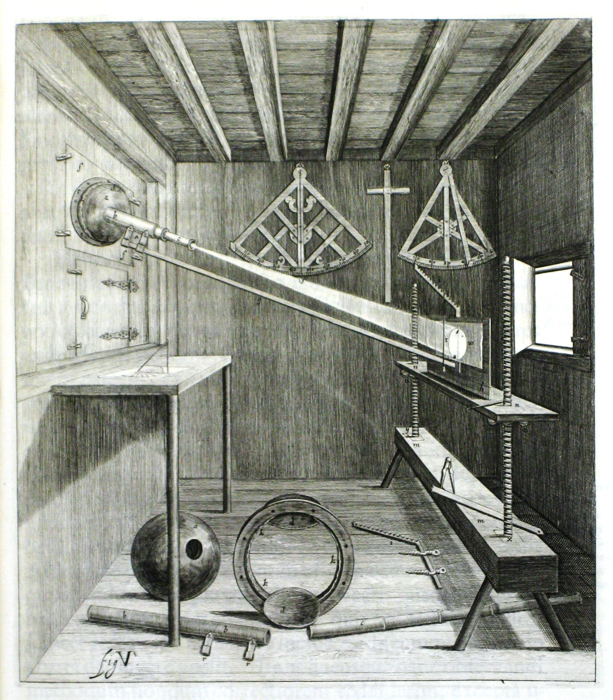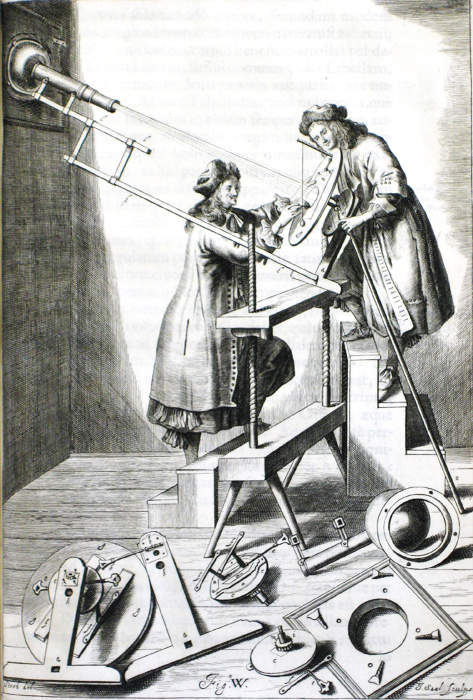The Sun
Johannes Hevelius, 1611-1687, the most famous Polish astronomer of the seventeenth century, was not only renowned for his observational skills but equally for the deluxe editions he produced at Danzig. His principal works were his Selenographia (Danzig, 1647) which examines contemporary knowledge of the Moon, his Cometographia (Danzig, 1668) which is a fascinating examination of comets, and his Machinae coelestis (Danzig, 1673) which portrays the advances made in the production of astronomical instruments in the seventeenth century – all of which were purchased by Worth alongside Hevelius’s Epistolae IV (Danzig, 1654) which outlines, among other things, his observations of a solar eclipse at Danzig in 1652.
Solar Eclipses
Hevelius: 1652 eclipse.
Johannes Hevelius, Epistolae IV (Danzig, 1654), plate.
The anonymous writer of the 1652 tract entitled Black Munday: or, a full and exact description of that great and terrible eclipse of the Sun which will happen on the 29 day of March 1652 beginning 48 minutes after 8. a clock in the forenoon and ending 17 minutes after 11 in which the Sun will be almost totally darkened (as at the Passion of our Saviour) and the Stars appear in the Firmament in the day time (London, 1652), was evidently hoping that this small tract of astrological predictions of doom would sell well. England was already convulsed by civil war and the expected solar eclipse could be taken as yet another sign of God’s wrath and impending social chaos. The astrological predictions and the rudimentary attempt at illustrating the projected eclipse are light years away from Hevelius’s careful discussion of the same eclipse as seen from Danzig in his published letter to the French astronomers Pierre Gassendi and Ismael Bullialdus.
This illustration of the declination of the Sun during the 1652 solar eclipse bears all the hallmarks of Hevelius’s output: he not only was a keen observer but was anxious to produce fine replications of his results, often going to the trouble of preparing the engravings himself. Certainly the complexity of his printing production is visible when we compare it with another depiction in a scholarly work – in this case of the 1640 solar eclipse viewed by Georg Marggraf at Recife, contained within Worth’s copy of Willem Piso’s De Indiae utriusque re naturali & medica libri quatuordecim (Amsterdam, 1658):
Piso – 1640 solar eclipse. Willem Piso, De Indiae utriusque re naturali & medica libri quatuordecim (Amsterdam, 1658), Sig. a2v.
Hevelius’s discussion compares the 1652 eclipse with an earlier one viewed at Danzig on 4 November 1649. His deliberations were published in a work published two years later, his Epistolae IV, four letters written to leading astronomers in Europe. This text only scratches the surface of Hevelius’s extensive astronomical friendship network which stretched as far as England, where he had met John Wallis in the 1630s and where he corresponded with the members of the Royal Society from the 1660s onwards. Equally his fame had spread to the great French observatory and in his later life he was able to supplement his income with financial support from Louis XIV.
Solar eclipses were evidently of interest to Worth since he also collected Giovanni Poleni’s Observatio solaris eclipsis habita Patavii V. nonas Maias MDCCXV published at Padua in 1715.
Giovanni Poleni, Observatio solaris eclipsis habita Patavii V. nonas Maias MDCCXV (Padua, 1715), title page.
Poleni, 1683-1761, was a professor of astronomy at Padua and, like Worth himself, a Fellow of Royal Society. Like many other astronomers across Europe he was anxious to publish his observations of this total eclipse of the Sun.
One of the many topics Hevelius’s Machinae coelestis deals with is the thorny problem of observing the Sun. Unlike the other planets, looking at the Sun for even short periods of time was dangerous to sight and therefore methods had to be developed to cope with this problem. In the two following illustrations we see how this problem was overcome:
Johannes Hevelius, Machinae coelestis (Danzig, 1673), Fig V.
In this first engraving we see how an observation of the Sun was made.
Johannes Hevelius, Machinae coelestis (Danzig, 1673), Fig W.
The second engraving details the process of recording observations of the Sun.
Refraction
Bu this was only one step in a process which was made yet more difficult by the complication of refraction, a problem which had dogged observational attempts throughout the middle ages and well into the sixteenth century. Another work in the Worth Library, John Bilberg’s, A Voyage of the Late King of Sweden, And another of Mathematicians, Sent by Him: In which are discover’d The Refraction of the Sun, which sets not in the Northern Parts, at the Time of the Summer Solstice, Variation of the Needles, Latitudes of Places, Seasons, &c. of those Countries. By Command of the Most Serene, and Most Mighty Prince, Charles XI. King of Sweden, Goths, and Vandals (London, 1698), sets out the problem as follows:
The Doctrine of Refraction (pp. 52-54):
… First of all it is very certain, that we learn by Experience, that the Rays which proceed from any visible Body, if they fall from a more sense Body upon a more rare, or on the contrary (which Philosophers use to term a different Medium) at this Entry the Ray proceeds no more strait forward, but is Refracted, and in its passage gets another way different from the former. This Assertion is proved many ways; but leaving the more subtil, we will explain it in a vulgar way not unknown to all People. Let some bright Piece be put into an empty Vessel, as Gold or Silver Money; whereby the splendid Ray may more easily represent the image to the Eye; then let him that makes the Experiment go so far from the empty Vessel that the Money being at the bottom is so covered with the Edges of the Vessel, that it cannot be discerned, let him stay in that place, and order Water to be poured out of another into this Vessel; which being done, the Money will appear through the Water to him in that Posture, being inconspicuous before; and that so much the higher as the Water is put in in greater plenty, by which it may be understood, that this visive Ray between the Money and the Eye is only Refracted in the highest Superficies of the Water, since a right Ray cannot be carried to the Eyes, remaining in the same Posture, from the Money, by the Opake sides of the Vessel: The reason is the same, when an Oar seems to be broken in the Water, where no other Cause can be given of this Fallacy of the sight, than the Inclination of the Ray of the things seen, from that side in which it enters a different Medium. Wherefore since the Solar Rays are right Lines, it is doubted, not without cause, if the Sun, and other Lucid Bodies in Heaven, be any where or every where discerned in their true places; but since it is for certain observed in the Eclipses of the Luminaries, that the places of the hidden Bodies, both true and apparent, are different not only by reason of the Parallaxes, but also Refractions, the strongest Argument of Astronomical Truth, and besides, some other Observations most deserving Credit, takes away all Doubt.’
Ptolemy, Alhazen and Witelo had all been aware of the problem of refraction but it was not until Tycho Brahe that accurate measurements of refraction were made. Kepler specifically turned his attention to the problem in his response to Witelo’s perspectivist optics, in his Ad Vitellionem paralipomena (Prague, 1604). Here he provided a single table of refractions for all the planets but reverted to Brahe’s separate refraction tables in his later and more popular work, Tabulae Rudolphinae (Ulm, 1627). With Descartes’s publication of Snel’s law of refraction in 1637 (included in a compilation of Descartes works in the Worth library), Kepler’s single table gained ground, yet despite their efforts, refraction continued to a source of frustration to astronomers throughout the seventeenth century as Billberg’s text makes clear. Billberg explains solar refractions as follows:
Diagram of Billberg, RefractionJohn Billberg, A Voyage of the Late King of Sweden (London, 1698), p. 58.
‘Let T. be the Center of the Earth, O. the Eye on the Plane of the Earth, A.B.C. the Superfices of the Atmosphere, where the more gross Air is separated from the thinner Æther. E.D.G. the Orbit of the Sun. O.B.D. the right Horizon Ray to the Sun appearing in D. Now it is certain that no Cœlestial Body can appear to the Eye, placed in O. before it shall come to the Point D. And further, because Experience teaches us, that it appears below O.B.D. that cannot be done except by a Ray Refracted; for this Ray wou’d fall sooner on the Convex of the Earth’s Globe, than upon the Horizontal Line O.B.D. and so that Body wou’d remain inconspicuous, the Ray S.B. falling from the Æther into a more dense Medium, to wit, the Atmosphere A.B.C. is Refracted, and in one part of it represents the Line B.O. when otherwise it wou’d have been produced to R. if the Medium had been the same, but not to the Eye, O. Hence it is certainly concluded, that the Sun appears on the Earth, sometimes before its Rising, when it seems to be discerned by us in an Horizontal Line, Q.E.D.
Billberg, A Voyage of the Late King of Sweden, pp. 59-60.
Selected Reading
Van Helden, A. (2003). ‘The Telescope and Cosmic Dimensions’ in Taton, R. And Wilson, C. (eds) Planetary astronomy from the Renaissance to the rise of astrophysics. Part A: Tycho Brahe to Newton. Cambridge: Cambridge University Press. The General History of Astronomy Series, pp. 106-118.Szanser, A. J. (1976) ‘Johannes Hevelius (1611-1687)-Astronomer of Polish Kings’, Quarterly Journal of the Royal Astronomical Society, 17, 488-498.




